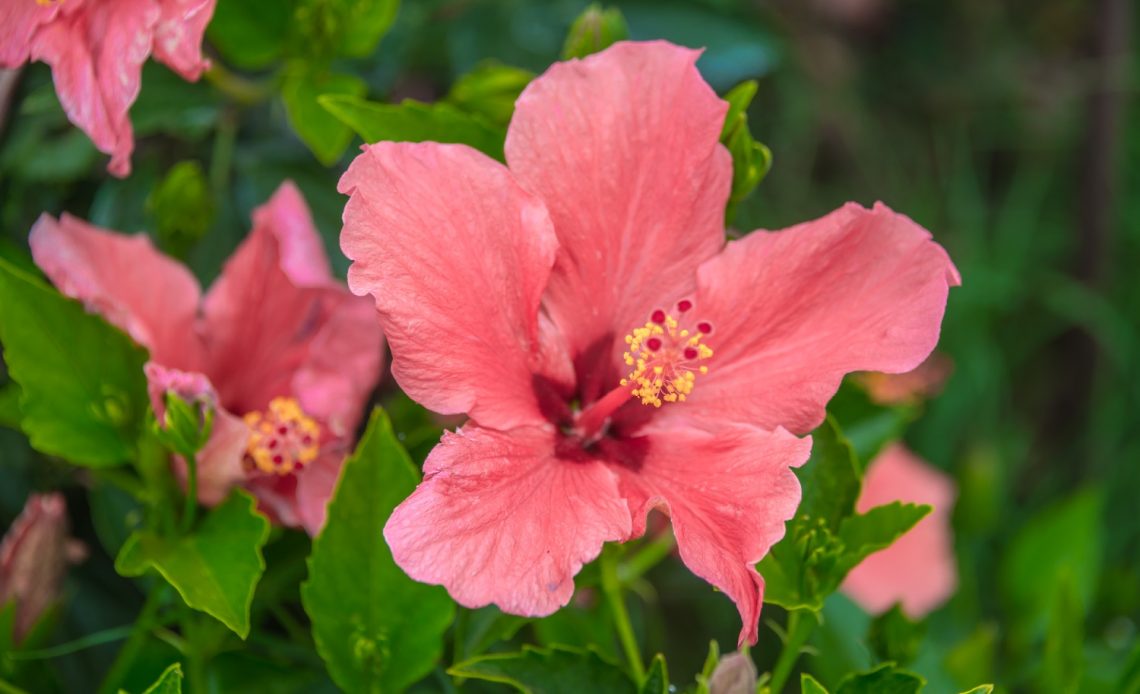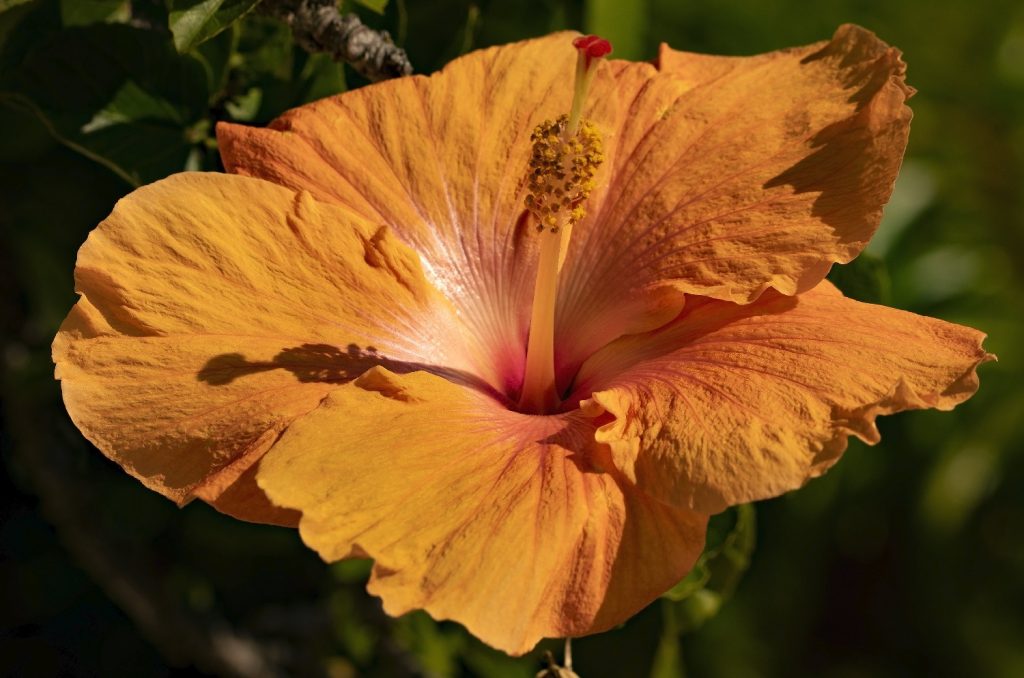

We’re here to help! Wild Yards is a completely free website that is 100% dedicated to helping you create a wildlife-friendly, sustainable yard. Read more
WildYards is reader-supported. When you buy a product through a link on our site, we may earn a comission. Every product is independently selected by our (obsessive) editors and our reviews are unbiased and objective. Read more about our mission or our privacy policy.
Deer will famously chow down on various plants and vegetables in your garden given half a chance. Despite this, their complex digestive systems can sometimes restrict what they will or won’t consume. For example, do deer eat hibiscus plants?
Deer will happily eat hibiscus. This is great news for those who want to attract deer to our yards – but not so much if you want to keep your colorful blooms to yourself. While hibiscus is great for attracting deer, it can sometimes encourage unwanted visitors.
Why do deer eat hibiscus?
Hibiscus is a fairly bland plant in terms of its fragrance and flavor. Deer, with sensitive ruminant digestive systems, eat green produce that is typically smooth, flavorless, and inoffensive. Some plants, such as those with thorns, fuzz, or strong fragrances, are unlikely to be eaten by deer as they may not be easy to digest.
The hibiscus is an eye-catching plant in the first instance, making it a firm favorite among pollinators such as bees, butterflies, and hummingbirds. Additionally, deer wandering close to your yard will likely spot a bold crop of hibiscus you’re growing in a bed.
Oddly enough, it’s not the flowers that prove tastiest or most useful to visiting deer. Deer that head to your garden are more likely to feast on the leaves, stems, and even tough wood of a hibiscus plant first. They’ll chow down on the flowers, of course, if they are positively starving!
Will deer eat all types of hibiscus?
Anecdotal evidence suggests that deer won’t necessarily eat all types of hibiscus in the wild. Moreover, not all species of deer will choose the hibiscus as their favorite plant to consume. Regardless of the type of hibiscus you grow – whether in a bush or a tree – its bland structure is likely to appeal to a roving deer.
Hibiscus trees are arguably less likely to attract damage from deer thanks to their height. Though, the plant structure can otherwise remain the same.
Some gardeners choose to grow hibiscus varieties such as the Diana or Pink Giant – as these flowers haven’t proven too popular with deer on the whole. That said, it is never wise to assume a deer won’t come and eat your hibiscus – never bank on the species alone.
Some experts suggest that deer are more likely to eat perennial hibiscus plants (i.e., those that flower in the spring and summer and die by fall) than annual varieties. We can surmise that annual hibiscus may have greater ‘competition’ in other deer-friendly plants during their growing periods and may get overlooked.

How can I prevent deer from eating my hibiscus?
Preventing deer from eating hibiscus may be as simple as growing plants deer dislike – or actively avoid – among your plot. For example, deer do not enjoy eating plants or flowers that are particularly tough or textured. Growing ferns, long grass, and coleus plants between your hibiscus may be enough to deter them from eating your precious blooms.
As the hibiscus is such an eye-catching plant, it makes sense to consider more drastic action if you want to protect your own from deer.
Humanely ‘scare’ deer away
Most deer’s fight or flight response is triggered by noises, smells, or sounds they don’t recognize. This explains why many of these animals are wary about entering gardens unless they know they can expect a snack! As hibiscus plants are some of many deer species’ favorite wild treats, you may have to humanely ward any would-be visitors away.
This may be as simple as setting up a sensor, motion-controlled light, or lamp in your garden. When triggered, deer will be illuminated and likely want to run away. The same applies if you add extra noise to your yard. You may choose to set up wind chimes, for example, or an electronic noise box to randomly deter deer.
The problem with these methods is that, in time, some deer may grow accustomed to the sights and sounds. It’s not unheard of for some deer (depending on species and even individual personality!) to grow ‘immune’ to distractions. If you want to protect your hibiscus even more, you may need to set up a physical barrier.
Improve your perimeter protection
If your yard is full of hibiscus or other plants that deer love, reinforcing or at least increasing the height of your basic perimeter is a must. Some species of deer can – and will – leap higher than eight feet in the air to access the food they know is on the other side of a wall, gate or fence!
Be sure to measure the height of your fence or gate. It’s best to opt for an opaque perimeter, such as a solid wall if you can. If deer can see and smell hibiscus in your yard, they may still make an effort to leap over.
You can also consider setting up double fencing or walling to prevent access if you wish. What’s also important is that you make sure your walls or fences have no gaps at the bottom, as these animals can (and will) dig underneath and squeeze their way in.
It’s worth remembering that if deer already know you have plants such as hibiscus in your yard, putting up a fence may not be enough – unless it is, as mentioned, tall and opaque.
Many experts recommend focusing on physical deterrents first and foremost – and you can also invest in netting to protect your plants, too.
Simply move your hibiscus!
Believe it or not, the closer your hibiscus plants are to your home, the less likely deer will want to eat them. It’s because there is an enhanced risk of these creatures getting spotted by you! You may not intend to harm deer that come into your yard (and I certainly hope you wouldn’t), but these creatures immediately assume strange creatures are likely to harm them.
Try moving your hibiscus plants under a window, where you’re likely to cast a shadow or look out from time to time. Try not to run out and ‘shoo’ deer away, as some are known to attack. Statistics show deer are some of the most dangerous animals in the US – don’t provoke them!
As well as moving your hibiscus plants closer to your home, consider moving plants deer don’t like as much to the edge of your yard, where they are likely to enter. Textured, coarse, prickly, and strong-smelling plants will deter deer from your garden, and they will only ever eat these specimens if they are extremely hungry.
It’s also worth avoiding growing new trees close to the edge of your yard or deer entrance, too – as deer will find the cover attractive. Consider keeping your yard’s far edge as clear as possible (ahead of your fence).
Should I keep growing hibiscus?
Yes! Hibiscus is a delightful plant to watch growing, and many varieties are extremely hardy – it’s also one of the best plants you can grow in a US garden to welcome pollinators. Whether you want to welcome deer to your yard or not, it’s still worth protecting these flowers as best you can.
If you don’t want deer to eat your hibiscus, simply move it close to your home, plant other less deer-friendly growths among the crop, and/or humanely deter creatures from taking a closer look.
